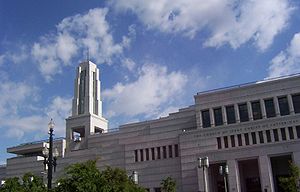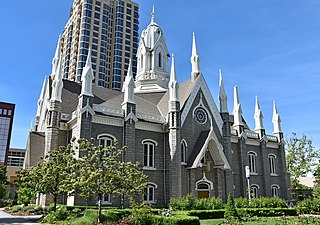
The Salt Lake Assembly Hall is a building owned by the Church of Jesus Christ of Latter-day Saints which sits on the southwest corner of Temple Square in Salt Lake City, Utah. It has seating capacity for an audience of approximately 1,400 people.

Henry Grow, Jr. was a Latter-day Saint (Mormon) builder and civil engineer in pioneer-era Utah. His most notable achievement was aiding the construction of the Salt Lake Tabernacle on Temple Square in Salt Lake City, Utah. Grow engineered the meeting hall's unique elongated dome roof.

Temple Square is a 10-acre (4.0 ha) complex, owned by the Church of Jesus Christ of Latter-day Saints, in the center of Salt Lake City, Utah. The usage of the name has gradually changed to include several other church facilities that are immediately adjacent to Temple Square. Contained within Temple Square are the Salt Lake Temple, Salt Lake Tabernacle, Salt Lake Assembly Hall, the Seagull Monument, and two visitors' centers. The square was designated a National Historic Landmark District in 1964, recognizing the Mormon achievement in the settlement of Utah.
William Harrison Folsom was an architect and contractor. He constructed many of the historic buildings in Utah, particularly in Salt Lake City. Many of his most prominent works were commissioned by the Church of Jesus Christ of Latter-day Saints. For a time he was sustained as the Church Architect, a calling in the church.
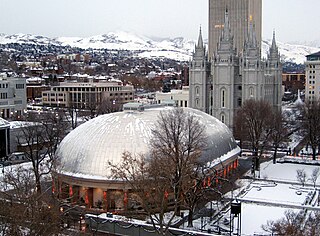
The Salt Lake Tabernacle, also known as the Mormon Tabernacle, is located on Temple Square in Salt Lake City, in the U.S. state of Utah. The Tabernacle was built from 1863 to 1875 to house meetings for the Church of Jesus Christ of Latter-day Saints. It was the location of the church's semi-annual general conference until the meeting was moved to the new and larger LDS Conference Center in 2000. Now a historic building on Temple Square, the Salt Lake Tabernacle is still used for overflow crowds during general conference. It is renowned for its remarkable acoustics and iconic pipe organ. The Tabernacle Choir has performed there for over 100 years.

Music & the Spoken Word is a religious radio and television series. Broadcast weekly from the Salt Lake Tabernacle in Salt Lake City, Utah, the program primarily features performances of music by Tabernacle Choir (Choir)—often accompanied by the Salt Lake Tabernacle organ and the Orchestra at Temple Square. The program also includes spiritual messages and passages related to a specific episode's theme, presented by Lloyd D. Newell.

The Joseph Smith Memorial Building, originally called the Hotel Utah, is a social center located on the corner of Main Street and South Temple in Salt Lake City. It is named in honor of Joseph Smith, the founder of the Latter Day Saint movement. It houses several restaurants and also functions as a venue for events. Several levels of the building also serve as administrative offices for the Church of Jesus Christ of Latter-day Saints departments such as FamilySearch. On January 3, 1978, it was added to the National Register of Historic Places as the Hotel Utah.

The Ogden Utah Temple is the sixteenth constructed and fourteenth operating temple of the Church of Jesus Christ of Latter-day Saints. Located in Ogden, Utah, it was originally built with a modern, single-spire design very similar to the Provo Utah Temple. During a renovation completed in 2014, the exterior and interior were extensively changed.

On December 27, 1832, two years after the organization of the Church of Christ, the movement's founder, Joseph Smith, stated he received a revelation that called upon church members to restore the practice of temple worship. The Latter Day Saints in Kirtland, Ohio were commanded to:
"Establish a house, even a house of prayer, a house of fasting, a house of faith, a house of learning, a house of glory, a house of order, a house of God."
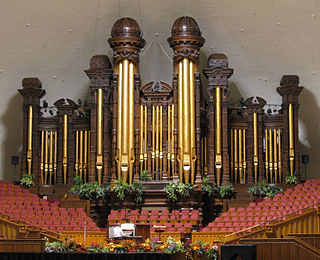
The Salt Lake Tabernacle organ is a pipe organ located in the Salt Lake Tabernacle in Salt Lake City, Utah. Along with the nearby Conference Center organ, it is typically used to accompany the Tabernacle Choir at Temple Square and is also featured in daily noon recitals. It is one of the largest organs in the world. Jack Bethards, president and tonal director of Schoenstein & Co., describes it as an "American classic organ" and "probably one of the most perfect organs ever built."
A solemn assembly is a formal and sacred procedure in the Church of Jesus Christ of Latter-day Saints conducted to give added emphasis to the purpose of the occasion. Solemn assemblies are held at the dedications of temples and for specially-called meetings to provide instruction to church leaders. Solemn assemblies are also held for the purpose of sustaining a new church president, who church members consider to be a prophet, seer, and revelator. Such assemblies are held, in particular, to follow the law of common consent. In 1831, a year after Joseph Smith established the Church of Christ, church members believe he was instructed by revelation to "call your solemn assembly, that your fastings and your mourning might come up into the ears of the Lord of Sabaoth." Historically, solemn assemblies were held on special occasions of major religious importance in ancient Israel.

The Church Administration Building (CAB) is an administrative office building in Salt Lake City, Utah, United States serving as the headquarters of the Church of Jesus Christ of Latter-day Saints (LDS Church), the fourth-largest Christian denomination in the United States. Completed in 1917, the building is adjacent to Temple Square, between the Joseph Smith Memorial Building and the Lion House, on South Temple Drive. It differs from the Church Office Building in that it is much smaller and furnishes offices for the First Presidency and the Quorum of the Twelve Apostles. It also houses offices for other general authorities and their personal staff.

The Schoenstein Organ at the Conference Center is a pipe organ built by Schoenstein & Co., San Francisco, California located in the Conference Center of the Church of Jesus Christ of Latter-day Saints in Salt Lake City, Utah. The organ was completed in 2003. It is composed of 160 speaking stops spread over five manuals and pedals. Along with the nearby Salt Lake Tabernacle organ, it is typically used to accompany the Tabernacle Choir at Temple Square. Schoenstein & Co.'s president and tonal director, Jack Bethards, describes it as "an American Romantic organ" that is "probably more English than anything else."

The Provo Tabernacle was a tabernacle of the Church of Jesus Christ of Latter-day Saints from 1898 to 2010 in downtown Provo, Utah, United States. It was a historic icon of Provo and had been home to many religious and cultural events. All but the outer walls of the building were destroyed by fire in December 2010. The LDS Church preserved the remaining outer walls and built a new foundation and interior as part of the Provo City Center Temple, completed in 2016.

In the Church of Jesus Christ of Latter-day Saints, a tabernacle is a multipurpose religious building, used for church services and conferences, and as community centers. Tabernacles were typically built as endeavors of multiple congregations, usually at the stake level. They differ from meetinghouses in scale and differ from temples in purpose.

The Provo City Center Temple is a temple of the Church of Jesus Christ of Latter-day Saints on the same site as the former Provo Tabernacle in Provo, Utah. Completed in 2016, the temple utilizes much of the external shell of the tabernacle, all that remained of the original building after a fire in December 2010.

The Old Salt Lake Tabernacle, was a tabernacle of the Church of Jesus Christ of Latter-day Saints that was built in 1852 in Salt Lake City, Utah Territory. It stood on Temple Square where the Salt Lake Assembly Hall now stands. The building was 126 feet long and 64 feet wide and seated 2,500. It was constructed of adobe bricks. It was also called the Old Tabernacle and the Adobe Tabernacle. It was the original home of the Mormon Tabernacle Choir. Improvements were made in 1860s, but it was demolished in 1877 and replaced with the Assembly Hall, a larger structure.

The following outline is provided as an overview of and a topical guide to the Church of Jesus Christ of Latter-day Saints.
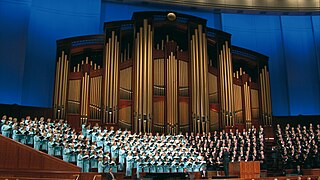
General Conference is a gathering of members of the Church of Jesus Christ of Latter-day Saints, held biannually every April and October at the Conference Center in Salt Lake City, Utah. During each conference, church members gather in a series of two-hour sessions to listen to the faith's leaders. It consists of five general sessions. From April 2018 to April 2021, the priesthood session was held during the April conference, with a General Women's Session held during October's conference. The Saturday evening session was changed to a general session in October 2021. The conference also generally includes training sessions for general and area leaders. Although each general conference originates from Salt Lake City, the conference is considered an international event for the church. The sessions are broadcast worldwide in over 90 languages, primarily through local and international media outlets, and over the Internet.
The architecture of the Church of Jesus Christ of Latter-day Saints includes the design and use of the church's temples, meetinghouses, historic sites, and other buildings and facilities. The LDS Church is known for its unique and often imposing architecture. The church's architecture differs based on the uses of individual buildings and varies in style throughout the world.


